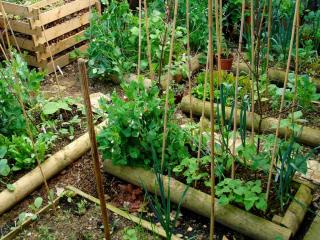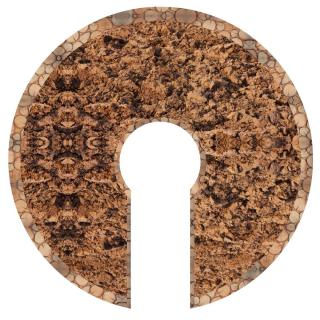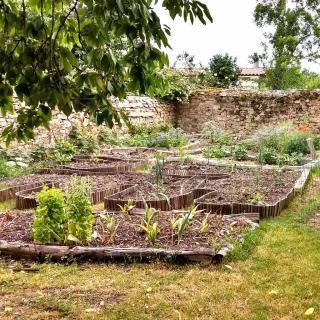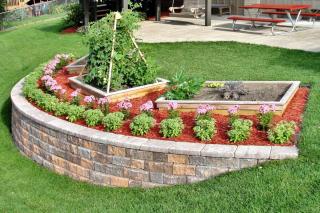

Raised gardening gets a resounding “yes”, doesn’t it? Now, the time has come to select the best layout for raised garden beds. Square, rectangles, curves and even a few intriguing keyhole shapes, find the pattern that fits the spot!
 This is the easiest to design and set up. Basically, rectangular beds are set up and aligned. Pathways are provided between them.
This is the easiest to design and set up. Basically, rectangular beds are set up and aligned. Pathways are provided between them.
Straight lines make for an ordered, elegant garden that is down-to-earth and efficient.
Materials can easily be recovered from pallets or spare planks.
 This particular design looks like a donut from above, with a slice cut out to reach the center. It’s very appealing and unique, though not so easy to set up because of the curved shape. Usually it’s about 6 to 8 feet across (2 to 2½ meters).
This particular design looks like a donut from above, with a slice cut out to reach the center. It’s very appealing and unique, though not so easy to set up because of the curved shape. Usually it’s about 6 to 8 feet across (2 to 2½ meters).
It’s possible to set several keyhole gardens near each other. A honeycomb-like pattern is best in this case.
Also, there are two versions of the keyhole garden: sometimes a compost collector takes the place of the center of the donut. In this case, reduce overall size to 5 feet across (140 cm), so you can come at it from all around the raised bed.
 The goal here is to maximize growing beds as opposed to pathways and walkways. It’s great for urban gardens and tiny gardens that want to grow as much food as can be in as little space as possible.
The goal here is to maximize growing beds as opposed to pathways and walkways. It’s great for urban gardens and tiny gardens that want to grow as much food as can be in as little space as possible.
In this case, you won’t have boxes set up one after the other with pathways between them. Instead, a single continuous walkway is mapped so that any growing space is within reach, like a maze with a single entry point that leads to one exit. The pathway can be either straight or curvy.
If you push this design to the extreme, you actually end up with a meditative labyrinth garden… cultivating your soul as well your food!
 Ideal for sloped gardens, this solution turns a problem into a great opportunity! Like the mystical rice terraces of the Far East, a hard-to-grow area becomes an abundant fruit basket.
Ideal for sloped gardens, this solution turns a problem into a great opportunity! Like the mystical rice terraces of the Far East, a hard-to-grow area becomes an abundant fruit basket.
Make sure your construction is firmly anchored to the ground in various points, especially if your area is prone to heavy rains: it’s a hassle when a small “landslide” occurs!
The key to a successful raised garden layout is two-fold.
→ For instance, herbs and spices should grow near your garden outdoor kitchen.
There’s a big chance you can even use a combination of all these patterns. Doing so will create different atmospheres in the garden depending on the point of view. You can recreate totally different ambiences as you create your flower beds or vegetables gardens!